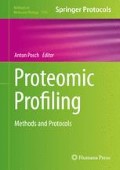Abstract
Mitochondria are key organelles for cellular energy production and cell death decisions. Consequently, a plethora of conditions which are toxic to cells are known to directly attack these organelles. However, mitochondria originating from different tissues differ in their sensitivity to toxic insults. Thus, in order to predict the potential organ-specific toxicity of a given drug or pathological condition at the mitochondrial level, test settings are needed that directly compare the responses and vulnerabilities of mitochondria from different organs. As a prerequisite for such test strategies, we provide here a robust, prompt, and easy-to-follow step-by-step protocol to simultaneously isolate functional and intact mitochondria from rat liver, kidney, heart, and brain. This isolation procedure ensures mitochondrial preparations of comparable purity and reproducible quantities which can be subsequently analyzed for organ-specific mitochondrial toxicity.
Access this chapter
Tax calculation will be finalised at checkout
Purchases are for personal use only
References
Löffler G, Petrides PE (1990) Biochemie und pathobiochemie, 5th edn. Springer, Berlin
Mootha VK et al (2003) Integrated analysis of protein composition, tissue diversity, and gene regulation in mouse mitochondria. Cell 115(5):629–640
Veltri KL, Espiritu M, Singh G (1990) Distinct genomic copy number in mitochondria of different mammalian organs. J Cell Physiol 143(1):160–164
Vijayasarathy C et al (1998) Variations in the subunit content and catalytic activity of the cytochrome c oxidase complex from different tissues and different cardiac compartments. Biochim Biophys Acta 1371(1):71–82
Tahara EB, Navarete FD, Kowaltowski AJ (2009) Tissue-, substrate-, and site-specific characteristics of mitochondrial reactive oxygen species generation. Free Radic Biol Med 46(9):1283–1297
Andreyev A, Fiskum G (1999) Calcium induced release of mitochondrial cytochrome c by different mechanisms selective for brain versus liver. Cell Death Differ 6(9):825–832
Berman SB, Watkins SC, Hastings TG (2000) Quantitative biochemical and ultrastructural comparison of mitochondrial permeability transition in isolated brain and liver mitochondria: evidence for reduced sensitivity of brain mitochondria. Exp Neurol 164(2):415–425
Hogeboom GH, Schneider WC, Pallade GE (1948) Cytochemical studies of mammalian tissues; isolation of intact mitochondria from rat liver; some biochemical properties of mitochondria and submicroscopic particulate material. J Biol Chem 172(2):619–635
Pallotti F, Lenaz G (2007) Isolation and subfractionation of mitochondria from animal cells and tissue culture lines. Methods Cell Biol 80:3–44
Petit PX et al (1998) Disruption of the outer mitochondrial membrane as a result of large amplitude swelling: the impact of irreversible permeability transition. FEBS Lett 426(1):111–116
Close B et al (1997) Recommendations for euthanasia of experimental animals: part 2. DGXT of the European Commission. Lab Anim 31(1):1–32
Fleischer S (1979) Long-term storage of mitochondria to preserve energy-linked functions. Methods Enzymol 55:28–32
Zamzami N, Metivier D, Kroemer G (2000) Quantitation of mitochondrial transmembrane potential in cells and in isolated mitochondria. Methods Enzymol 322:208–213
Schmitt S et al (2014) Mitochondrion 19(Pt A):113-123. doi:10.1016/j.mito.2014.06.005.
Acknowledgements
We would like to acknowledge E.E. Rojo for critical reading of the manuscript. This study was supported in parts by the Deutsche Forschungsgemeinschaft (DFG) grant RU742/6-1 to H.Z.
Author information
Authors and Affiliations
Corresponding author
Editor information
Editors and Affiliations
Rights and permissions
Copyright information
© 2015 Springer Science+Business Media New York
About this protocol
Cite this protocol
Schulz, S. et al. (2015). A Protocol for the Parallel Isolation of Intact Mitochondria from Rat Liver, Kidney, Heart, and Brain. In: Posch, A. (eds) Proteomic Profiling. Methods in Molecular Biology, vol 1295. Humana Press, New York, NY. https://doi.org/10.1007/978-1-4939-2550-6_7
Download citation
DOI: https://doi.org/10.1007/978-1-4939-2550-6_7
Publisher Name: Humana Press, New York, NY
Print ISBN: 978-1-4939-2549-0
Online ISBN: 978-1-4939-2550-6
eBook Packages: Springer Protocols

